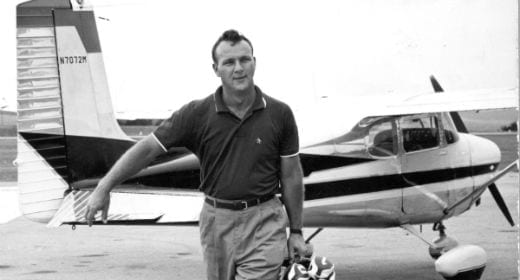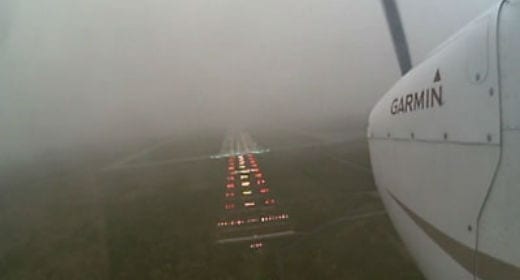
Top 10 activities for a cross country flight
Technique“Flying is boring,” said no pilot. Ever. Although most will agree that on a long VFR cross country flight, there are stretches of time when your mind can wander. Other than doing the usual drill during those lulls, here are some suggestions to put slack time to good use. In classic David Letterman style, here are the top 10 activities for a cross country flight.

Masters of the magenta – the real story
TechniqueToday, those seeking private pilot training have choices. There is now a fork in the road created by the introduction of TAA. Take the left fork to good old-fashioned seat-of-the-pants, look-out-the-window, finger-on-the-map flight training. Veer to the right and enter a world where bright lights, buttons and knobs take center stage.

What every VFR pilot needs to know about arriving IFR traffic
TechniqueVFR pilots operate in the same airspace as commercial IFR jet aircraft without having to ever hit the push-to-talk button. Most of the time things go just fine and the two operate without running into each other. Not having a requirement to talk to anyone doesn’t alleviate your responsibility as a small airplane driver to understand the airspace around you, though.

Helicopter techniques – (not) for dummies
TechniqueSome time after having served as a bush pilot and mechanic in the tropical rain forests of Borneo as well as in the high mountain regions of Papua – Irian Jaya for a few years, I was asked to present a lecture to a symposium of the Christian Pilots Association CPV in Germany, to broach the issue of advantages and limitations of helicopter operations in mission aviation.

How safe are you?
TechniqueBefore I obtained an instrument rating and began using IFR charts, I, too, relied primarily on visual cues; I never paid a lot of attention to actual geodetic elevations of obstacles and terrain. This type of “feel-as-you-go” operation is fine in good, daytime visibility. But in darkness or reduced visibilities, it can quickly lead to disaster. Simply said, when the visibility goes down, you need a better plan.

5 things every IFR pilot needs to say
TechniqueSingle Pilot IFR is one of the most dangerous types of flying in general aviation, because it requires high workload and multitasking. The human brain is always more effective when it can focus on one thing; that one thing should be flying the airplane. Over the years I’ve found five key phrases that, when told to ATC, reduce workload and make IFR much easier.

Not all preflights are created equal – 4 different approaches
TechniqueThe detail and depth of a preflight inspection can vary from day to day based on the type of airplane we are flying, where that airplane is parked, and even whether recent maintenance has been conducted. Let's talk about our preflight attitude or mindset for renters/flying clubs/partnerships, individual owners, Part 135 or Part 91 corporate operations, and airplanes fresh out of maintenance.

IFR departures: the forgotten procedure
TechniqueInstrument pilots obsess about approaches: if you can keep those needles crossed all the way down to 200 ft, you must be a good pilot. While shooting an ILS to minimums is an important skill, this all presupposes you managed to depart safely. Unfortunately, NTSB reports prove that's a big assumption - each year, a few pilots tragically learn that IFR departures aren't as simple as they seem.

Are doctors bad pilots?
TechniqueAs the adage goes, the superior pilot will avoid demonstration of superior skills through superior judgment. The pilot who is extremely nervous before every flight may have a genuine concern for their ability, but a pilot without any self-questions or ongoing self-assessment may be supremely confident, yet much more dangerous. The best pilot is somewhere in between.

New circling approaches – what’s changed and what hasn’t
TechniqueHave you flown a circle-to-land approach recently, for real? By any chance did you notice that down in the profile view at the bottom, where the circling minimums are shown, the letter "C" is now in bold and it is just slightly larger? You might have missed it.

7 ways to scare yourself in an airplane
TechniqueMost pilots aren't dare devils, but sometimes the only way to learn an important lesson is to scare yourself just a little. That doesn't mean we should seek out frightening experiences, only that we should try to learn from them when we inevitably stumble into one. Here are seven common ways to scare yourself in an airplane, and I'm sad to say I've experienced all of them (but only once!).

Aircraft ownership – taking the plunge
TechniqueI tell people that I have learned more about flying in the time I have owned an aircraft than all the years before. Do your homework, and the day you become an aircraft owner will likely be one of the happiest of your life without another being the day you sell it!

Practical tips for family flying – how to keep everyone happy
TechniqueIf you are a flying family, or want to be one, you will quickly realize that there is very little information online about flying with kids. I can tell you how much flying with your family is great, amazing, rewarding etc., but you probably don’t need too much convincing - you need the HOW. So here is my HOW.

Flying on the ground – 7 tips on staying current
TechniqueWhat can I do, a measly college student, who can only fly every so often? How can I stay current and make sure that the next time I sit behind the yoke again, be it tomorrow or a year from now, I can be assured I’ll know what to do?

10 tips for prospective businessmen (or businesswomen) pilots
TechniqueIf you are serious about moving you and your loved ones around by air, here are 10 things I have learned that I never read anywhere else. It is more rewarding and more fun than I ever imagined. It’s a lot of other things, too, nearly all of them good.

Real world missed approaches – 6 tips for staying safe
TechniqueThe missed approach is really a maximum performance maneuver. The key is to make your decisions long before you ever start the approach, so a missed approach is an automatic reaction. MDA is no time to be making decisions; it's a time for executing what you've already planned.

All runways are the same (sort of)
TechniqueThe biggest problem I used to have as a pilot was landing at different airports. I used to say, “I hate this airport; the runways are different…” Strange but I never have problems parking my car in a different lot, with spaces that face a different direction than my normal office lot. I still have to put the car in the middle and pointed straight!

Airspeed vs. angle of attack – what pilots don’t understand
TechniqueMost pilots don’t really understand the relationship between airspeed and angle of attack. If they did, we would not have the loss of control accidents that we do. We fly strictly by numbers because we were taught that way. Very few flight instructors have any experience or knowledge in this area.

Where is your checklist? Make your own
TechniqueDespite the obvious benefits of using checklists, many pilots fail to recognize the real cognitive value of checklists lies in the process of creating them. One of my favorite activities when purchasing or transitioning to a different light aircraft is creating my set of checklists for it. Having completed six now, I have a pretty good idea of the process.

Managing risk in flying: cognitive traps!
TechniqueThe most critical skill in aviation safety is making good decisions, both before flight when time is plentiful and in flight when circumstances change and we may be rushed. The ability to generate and decide between diverse options (often with incomplete information and in the crunch) is essential to mitigate risk and achieve a safe outcome.
